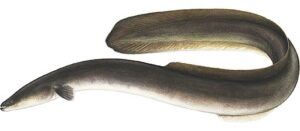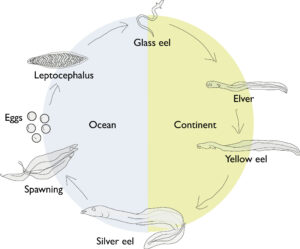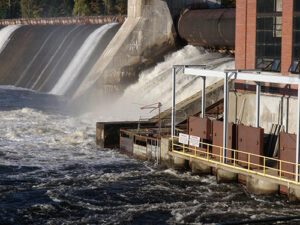Eels and energy: Can we have both?
 Matthew Mensinger has been fascinated with fish since childhood. Now he studies the hazards American eels face from hydroelectric dams and seeks solutions that help eels survive while preserving power generation.
Matthew Mensinger has been fascinated with fish since childhood. Now he studies the hazards American eels face from hydroelectric dams and seeks solutions that help eels survive while preserving power generation.
August 2020
Midwesterner Matt Mensinger spent every summer of his childhood on Cape Cod, fishing and learning about marine biology at the Children’s School of Science while his dad conducted fish research at the Marine Biological Laboratory at Woods Hole.
The UMaine master’s student in wildlife, fisheries, and conservation biology hasn’t strayed far from his roots and is now tagging and tracking American eels in the Penobscot River to better understand their migratory behavior as they navigate the hazards posed by hydroelectric dams. This increased understanding could help dam managers find ways to lessen the dangers to eels, without sacrificing significant power generation. It could also be used to negotiate terms in the federal relicensing of hydroelectric dams through the Federal Energy Regulatory Commission (FERC) to help balance ecological, social and economic needs.

American eels (Anguilla rostrata) spawn in the Sargasso Sea — a circular system of ocean currents also called the North Atlantic Gyre — and migrate to rivers, lakes and estuaries where they spend the majority of their lives, from the Caribbean to the Canadian Maritimes. The eel larvae, which look like transparent willow leaves, enter the Gulf Stream current to be carried north after spending months drifting in the ocean. As they develop into young eels and enter fresh water, they are known as “glass eels” or “elvers.” After years or even decades in fresh water they migrate back to the Sargasso Sea as adults in what’s known as the “silver stage,” when they develop a dark upper surface and a silvery underside. These adult silver eels can weigh up to several pounds and be nearly a yard long.
Over the last few decades there have been significant population declines in American eels along the eastern seaboard of the U.S. In trying to figure out why, scientists began to look at the impacts hydroelectric dams have on migrating eels. They discovered that dams pose a number of risks to eels as they make their way toward the sea, with the number one risk being injury and death when passing through dam turbines.
“You can imagine a three-foot-long eel, an inch in diameter, going through a turbine blade,” Matt says. “There can be immediate mortality from turbine strikes or they may be injured and die later.”
Another risk to migrating eels is potential delays caused by dams, as eels spend more time looking for a way to get downstream. Such delays can deplete eels’ energy reserves, which negatively affects their chances of making it back to the Sargasso.
And often, eels face not just one but multiple dams as they migrate to the sea to spawn, compounding these risks.
Due to their declining populations and the threats they face, American eels have twice been considered (in 2007 and 2015) for protection under the Endangered Species Act. Both times listing was deemed unnecessary by the U.S. Fish and Wildlife Service because the population was considered “depleted but stable.” But many conservation organizations continue to worry about eels’ uncertain future.
Tracking eel migration in the Penobscot River

Matt joined the Mitchell Center’s Future of Dams team in fall 2018 to investigate the effects of hydropower dams on eel passage. The Future of Dams, a project funded by a four-year, $6 million National Science Foundation EPSCoR grant, focuses on developing decision-making tools that help stakeholders evaluate the ecological and economic tradeoffs associated with dams.
Matt’s research involves catching silver eels every fall at a weir on a tributary of the Penobscot River as they begin their migration from the freshwater streams and lakes back to the Sargasso Sea. The weir was operated every night from September through November and checked every morning for silver eels.
The research is supervised by Joe Zydlewski and Erik Blomberg. Joe is assistant unit leader at the U.S. Geological Survey’s Maine Cooperative Fish and Wildlife Research Unit and professor of fisheries science in the Department of Wildlife, Fisheries, and Conservation Biology at UMaine, and Erik is associate professor in the same department.
Once the silver eels are netted, Matt and his research team surgically implant acoustic tags by making a small incision in the eels’ abdomens. Each year, about 100 adult silver eels are tagged and then released upstream of two dams in the Penobscot River, in West Enfield and Milford. The eels’ movements are then tracked by a network of 60 underwater acoustic receivers that detect a uniquely identifiable “ping” from each eel as it moves downstream.

“And from that we can construct a history of each eel as it’s moving throughout the river on its journey back to the Sargasso Sea,” Matt says.
Turbines, timing and tradeoffs
The operation of hydroelectric dams, and efforts to protect eels as they migrate, inevitably involve tradeoffs. Shutting down turbines, or providing spillways for eels to go around turbines instead of through them, make the eels’ downstream journey safer. But hydroelectric dams are a major source of renewable energy, and any time turbines are shut down or river flow is diverted to a spillway, dam operators lose revenue.
Because eels generally migrate in darkness, dam operators could potentially shut down turbines at night to reduce impacts on eels, while limiting power generation losses. Work in other rivers suggests that shutting down turbines at night could be a viable strategy for protecting eels.
One study published in 2016 investigated the timing of turbine shutdowns at five hydroelectric dams on a stretch of the Shenandoah River in Virginia and West Virginia, and the effects of the shutdowns on migrating eels. Turbines were shut down at night from September 15 to December 15. During this time, mortality for eels passing all five dams was reduced by more than one third (from 63% to 37%), indicating that timing turbine shutdowns at night can significantly reduce eel deaths.
To do this effectively, timing is everything. “Trying to understand how to best predict when and how eels move is the key component,” notes Joe Zydlewski. “The timing of eel migration is dependent on environmental conditions such as lunar phase, temperature and water flow, which can be used to predict when eels are most likely to move downstream.”
Matt’s research, which builds on previous work in the Future of Dams project, set out to do three main things: track eels as they migrate downstream in a tributary of the Penobscot River; quantify how many eels are killed as they pass the West Enfield and Milford dams; and collect data to identify how various environmental factors affect the timing of eel migration.

The results from Matt’s research show that passing one dam during downstream migration results in the death of 10-15% of eels. Eels are killed directly by turbine blades, and they also die farther downstream from injuries sustained during dam passage.
But the threat to eel survival posed by dams is likely much greater, because most eels have to run a gauntlet of multiple dams as they migrate downstream. Matt’s research is among the first to look at this multi-dam effect. It shows that the survival of eels trying to pass two consecutive dams is even lower than would be expected from adding together the impacts of two individual dams.
Joe Zydlewski describes the cumulative effects of passing more than one dam this way: “Running a 10K is hard; running one race after just completing another is much harder because you’ve used up a lot of energy finishing the first.”
Even if eels successfully pass a dam, Matt’s data shows that their downstream migration may be delayed because of the additional time they have to spend navigating past the dam. Such delays can deplete the energy stores that eels need to reach their spawning grounds, more than a thousand miles away.
With four years of data, Matt’s research also gives a much better picture of how eel survival varies from year to year. For example, the data indicate that in years when river flows and corresponding water levels are higher, more eels survive, likely because it is easier to bypass turbines as the eels move downstream. This could potentially allow turbine shutdowns to be limited or avoided altogether when river flow is high enough, benefitting both eels and hydropower generation.
Informing dam operations and relicensing
Throughout New England, more than 50 dams will be up for relicensing in the next 10 years. In Maine, these include the Milford Dam in 2028, and the West Enfield dam in 2022, as well as six other dams in the Penobscot River Basin. The dam relicensing process takes at least five years, often longer, and involves intensive negotiations among dam operators, state and federal agencies, and conservation organizations such as The Nature Conservancy. Dams are typically licensed for 30-50 years.
Jeff Murphy, a consultation biologist and Endangered Species Act hydropower specialist with NOAA Fisheries, notes that it is “extremely important” to have solid data and information on which to base decisions during the FERC relicensing process. He also says that there has been “a lot of momentum” in the past decade to incorporate the protection of migrating eels during relicensing.
“This is exactly the kind of research we need as we strive to find a better balance between the needs of functional, healthy natural systems and the need for renewable energy.”
-Joshua Royte, senior conservation scientist, The Nature Conservancy
The U.S. Fish and Wildlife Service (USFWS) has asked for data from the eels research that Matt is working on, for use in licensing applications.
Jeff cites another Maine hydroelectric dam as an example of the importance of valid data and information to protect wildlife while supporting energy production: the Weldon dam on the main stem of the Penobscot River, which is currently in the midst of relicensing. In FERC’s September 2018 “Final Environmental Assessment for Hydropower License,” night-time turbine shutdowns to protect migrating eels are included in a list of proposed measures to reduce the dam’s environmental impacts.
Joshua Royte is senior conservation scientist for The Nature Conservancy in Maine. He notes, “This is exactly the kind of research we need as we strive to find a better balance between the needs of functional, healthy natural systems and the need for renewable energy. By gaining a clearer understanding of the timing and factors that trigger eel migration, we may identify windows of time when turbine operations can be stopped, and thus most of the eel mortality, without a significant loss of overall power generation.”
Research Funding:
Support for this research is provided by the National Science Foundation’s Research Infrastructure Improvement NSF #IIA-1539071, The Nature Conservancy, and the University of Maine.
In-kind support was provided by the U.S. Geological Survey Maine Cooperative Fish and Wildlife Research Unit.
